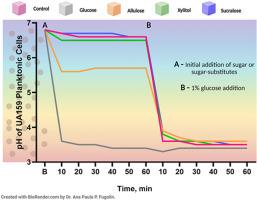The effect of allulose, sucralose, and xylitol on Streptococcus mutans acid production
引用次数: 0
Abstract
Background
Caries is a bacterial infection driven by a dysbiotic biofilm enriched and fueled by sugar. Frequent consumption of sugar can impart negative health effects, including caries; thus, there is increased interest in identifying less cariogenic sugar substitutes. In this study, the authors investigated the in vitro pH shift by Streptococcus mutans planktonic cells in the presence of various sugars and sugar substitutes.
Methods
S mutans UA159 cells were suspended in a potassium chloride and magnesium chloride salt solution, and acidogenesis was determined by pH drop assay after the additions of sugars (sucrose, glucose, fructose) or sugar substitutes (allulose, sucralose, xylitol). The pH of S mutans cell suspensions was recorded at 10-minute intervals for 1 hour. Planktonic cells were then challenged with glucose and pH was monitored for an additional hour.
Results
All sugars resulted in an initial pH drop to 3.5. For xylitol and sucralose, the pH drop was minimal. Allulose initially dropped to a pH of 5.4 before leveling to 5.7. In subsequent glucose challenges, all S mutans cell suspensions with sugar substitutes dropped to pH 3.5.
Conclusions
Allulose, sucralose, and xylitol did not cause a pH drop as low as sugars, and were not considered cariogenic, except for allulose potentially causing root caries. Sugar substitutes were not able to prevent a pH drop to near 3.5 after the glucose challenge indicating these substitutes are not anticariogenic in the presence of glucose.

异丙糖、三氯蔗糖和木糖醇对变形链球菌产酸的影响
龋齿是一种细菌感染,由一种由糖驱动的益生菌生物膜引起。频繁食用糖会对健康产生负面影响,包括龋齿;因此,人们对鉴定低致癌性糖替代品的兴趣越来越大。在这项研究中,作者研究了变形链球菌浮游细胞在不同糖和糖替代品存在下的体外pH值变化。方法将突变体UA159细胞悬浮于氯化钾和氯化镁盐溶液中,加入糖(蔗糖、葡萄糖、果糖)或糖替代品(allulose、三氯蔗糖、木糖醇)后,通过pH下降法测定其酸生成情况。每隔10分钟记录突变S细胞悬液的pH值,持续1小时。然后用葡萄糖刺激浮游细胞,再监测pH值一个小时。结果所有糖导致初始pH值降至3.5。木糖醇和三氯蔗糖的pH值下降最小。在达到5.7之前,Allulose的pH值最初下降到5.4。在随后的葡萄糖挑战中,所有含有糖替代品的S突变细胞悬浮液的pH值降至3.5。结论除allulose可能引起牙根龋外,allulose、三氯蔗糖和木糖醇不会引起像糖那样低的pH值,也不会引起龋病。糖替代品不能阻止葡萄糖刺激后pH降至3.5附近,这表明这些替代品在葡萄糖存在下没有抗癌作用。
本文章由计算机程序翻译,如有差异,请以英文原文为准。
求助全文
约1分钟内获得全文
求助全文

 求助内容:
求助内容: 应助结果提醒方式:
应助结果提醒方式:


